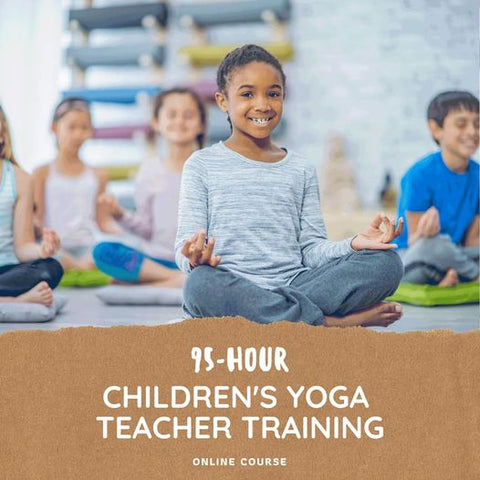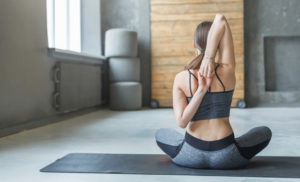2020 has been a year for sure — full of lives lost and lives forever changed. Social and political turbulence has made a global pandemic feel even more uncertain and challenging. Here at Flow and Grow Kids Yoga, we’re doing our best to learn, share, and grow together through it all — always towards the mission of sharing yoga’s gifts with children and the adults in their lives.
We’ve learned a lot and faced unprecedented difficulties together. Conversations with other leaders in the kids yoga and mindfulness space have highlighted the common challenges that we face and that we are always stronger standing together. From all of that, here are some lessons that I learned from kids yoga in 2020.

Students in Flow and Grow Kids Yoga classes, taking flight in Airplane Pose!
1. When everything else goes away, you have yourself.
With COVID 19 canceling school as we knew it, sport teams, yoga programming, social groups, and most other activities kids depend on, they were left at home with little constant to rely on. The structure of a typical child’s life — going to school, extra curricular activities, time and home, time with friends and family — is helpful for their development. Yet, in an instant, all of that changed and went away.
In my work with children one-on-one, we focused on developing personal practice. Kids can rely on themselves no matter what else changes. To support personal practice, I gave out personal practice ideas every week for the past 10 weeks in my Self-Care Saturday program. You can use those to help guide the children you love into personal practice, or email me to set up private lessons via Zoom.
2. Individual attention makes a world of difference.
In these one-on-one and semi private sessions, I’ve seen what a difference individual attention makes. Group classes have a wonderful energy and a meaningful purpose. Yet a special thing about yoga is how it’s so adaptable to our particular needs, wants, strengths, and growth areas at any particular time. The practice meets us where we are, and — if we feed it with mindfulness and commitment — it takes us somewhere new and profound.

Lara teaching private yoga over Zoom
One-on-one and semi-private classes can capitalize on all of that to create remarkable results. With children, they’re developing at their own speeds and in their own ways, so yoga practice designed just for them can make an incredible difference in their day-to-day functioning and overall development. Want to learn how to design yoga classes for kids and youth that get real results? Check out our lesson planning course!
3. We can be creative about how we reach kids.
Many sectors are re-thinking their “playbook” of how they engage with customers/clients, the wider public, and internally. Yoga is certainly one of them; classes are happening over social media, Zoom, educational videoconferencing programs like Smartboard Livestream, and more. When the weather is right for it, teachers are also meeting their students outdoors — people moving together under the sky just as our ancestors did.

A peace corner — a COVID-friendly kids yoga and mindfulness tool!
With certain adaptations (such as with steps taken for internet safety over social media and Zoom), all of that is possible with kids yoga and mindfulness as well! Various class structure options are possible on all of those platforms — group class, one-on-one, and semi-private.
Educators have validated it: by and large, kids are remarkably adaptable (of course with exceptions, such as in cases of specific individual needs). Can we adults be as adaptable, willing to be open to new paradigms and possibilities? Our The Business of Kids Yoga course offers know-how, strategies, as well as how you (yes you) can make a difference with kids yoga and mindfulness in a way that’s attainable and sustainable.
4. Personal practice is the basis for quality teaching.
For some yogis and yoginis, COVID has offered time and space to reconnect with practice (for others who are parents of little ones or front-line workers, maybe not so much). Practitioners who are also teachers have been able to explore practice in new ways and bring the fruits of that exploration to their students (albeit, meeting them virtually or socially-distanced and masked outdoors).
Simply put, that process is necessary for teachers to offer their best to their students. We at Flow and Grow Kids Yoga, as well as our colleagues, are seeing that more clearly than ever. The importance of personal practice in one’s teaching permeates all of our trainings and other professional development offerings.

A session in our fall training over Zoom
5. Being real with kids about your emotions helps them to be real about theirs.
We can then, together, work on coping tools. 2020 has pushed so many of us to our mental and emotional limits. As discussed, kids are remarkably adaptable — but imagine yourself in this situation at your child or your students’ age: separated from the familiarity of academics, friends, and extra-curriculars without time to adjust in any way.
If we are honest about how we’re feeling, in ways that are appropriate and accessible to the children and our lives (according to their age and developmental level), that opens a door — a door for a conversation on how to handle it all, with concrete and effective coping tools.
Then, no one has to face it alone. There is no shame or blame. There’s only support, dialogue, and working together on actionable strategies. The value of social support is certainly one thing, among others, that 2020 has made all the clearer for us. Let’s put it to work for ourselves and the children we love.
Our trainings are adaptable to, and change with, the times; we cover how to teach in different settings in ways that are fulfilling and sustainable for *you*, as well as how you can forge your own path when the existing ones aren’t quite right for you (or you just see a need or an opportunity out there that’s unmet!). You can learn more here. Take the whole 95 hour training or mix and match courses to create a curriculum that serves your needs and interests — we’re flexible and here to help guide you!
2020 has been a year for sure — full of lives lost and lives forever changed. Social and political turbulence has made a global pandemic feel even more uncertain and challenging. Here at Flow and Grow Kids Yoga, we’re doing our best to learn, share, and grow together through it all — always towards the mission of sharing yoga’s gifts with children and the adults in their lives.
We’ve learned a lot and faced unprecedented difficulties together. Conversations with other leaders in the kids yoga and mindfulness space have highlighted the common challenges that we face and that we are always stronger standing together. From all of that, here are some lessons that I learned from kids yoga in 2020.
Students in Flow and Grow Kids Yoga classes, taking flight in Airplane Pose!
1. When everything else goes away, you have yourself.
With COVID 19 canceling school as we knew it, sport teams, yoga programming, social groups, and most other activities kids depend on, they were left at home with little constant to rely on. The structure of a typical child’s life — going to school, extra curricular activities, time and home, time with friends and family — is helpful for their development. Yet, in an instant, all of that changed and went away.
In my work with children one-on-one, we focused on developing personal practice. Kids can rely on themselves no matter what else changes. To support personal practice, I gave out personal practice ideas every week for the past 10 weeks in my Self-Care Saturday program. You can use those to help guide the children you love into personal practice, or email me to set up private lessons via Zoom.
2. Individual attention makes a world of difference.
In these one-on-one and semi private sessions, I’ve seen what a difference individual attention makes. Group classes have a wonderful energy and a meaningful purpose. Yet a special thing about yoga is how it’s so adaptable to our particular needs, wants, strengths, and growth areas at any particular time. The practice meets us where we are, and — if we feed it with mindfulness and commitment — it takes us somewhere new and profound.
Lara teaching private yoga over Zoom
One-on-one and semi-private classes can capitalize on all of that to create remarkable results. With children, they’re developing at their own speeds and in their own ways, so yoga practice designed just for them can make an incredible difference in their day-to-day functioning and overall development. Want to learn how to design yoga classes for kids and youth that get real results? Check out our lesson planning course!
3. We can be creative about how we reach kids.
Many sectors are re-thinking their “playbook” of how they engage with customers/clients, the wider public, and internally. Yoga is certainly one of them; classes are happening over social media, Zoom, educational videoconferencing programs like Smartboard Livestream, and more. When the weather is right for it, teachers are also meeting their students outdoors — people moving together under the sky just as our ancestors did.
A peace corner — a COVID-friendly kids yoga and mindfulness tool!
With certain adaptations (such as with steps taken for internet safety over social media and Zoom), all of that is possible with kids yoga and mindfulness as well! Various class structure options are possible on all of those platforms — group class, one-on-one, and semi-private.
Educators have validated it: by and large, kids are remarkably adaptable (of course with exceptions, such as in cases of specific individual needs). Can we adults be as adaptable, willing to be open to new paradigms and possibilities? Our The Business of Kids Yoga course offers know-how, strategies, as well as how you (yes you) can make a difference with kids yoga and mindfulness in a way that’s attainable and sustainable.
4. Personal practice is the basis for quality teaching.
For some yogis and yoginis, COVID has offered time and space to reconnect with practice (for others who are parents of little ones or front-line workers, maybe not so much). Practitioners who are also teachers have been able to explore practice in new ways and bring the fruits of that exploration to their students (albeit, meeting them virtually or socially-distanced and masked outdoors).
Simply put, that process is necessary for teachers to offer their best to their students. We at Flow and Grow Kids Yoga, as well as our colleagues, are seeing that more clearly than ever. The importance of personal practice in one’s teaching permeates all of our trainings and other professional development offerings.
A session in our fall training over Zoom
5. Being real with kids about your emotions helps them to be real about theirs.
We can then, together, work on coping tools. 2020 has pushed so many of us to our mental and emotional limits. As discussed, kids are remarkably adaptable — but imagine yourself in this situation at your child or your students’ age: separated from the familiarity of academics, friends, and extra-curriculars without time to adjust in any way.
If we are honest about how we’re feeling, in ways that are appropriate and accessible to the children and our lives (according to their age and developmental level), that opens a door — a door for a conversation on how to handle it all, with concrete and effective coping tools.
Then, no one has to face it alone. There is no shame or blame. There’s only support, dialogue, and working together on actionable strategies. The value of social support is certainly one thing, among others, that 2020 has made all the clearer for us. Let’s put it to work for ourselves and the children we love.
Our trainings are adaptable to, and change with, the times; we cover how to teach in different settings in ways that are fulfilling and sustainable for *you*, as well as how you can forge your own path when the existing ones aren’t quite right for you (or you just see a need or an opportunity out there that’s unmet!). You can learn more here. Take the whole 95 hour training or mix and match courses to create a curriculum that serves your needs and interests — we’re flexible and here to help guide you!








